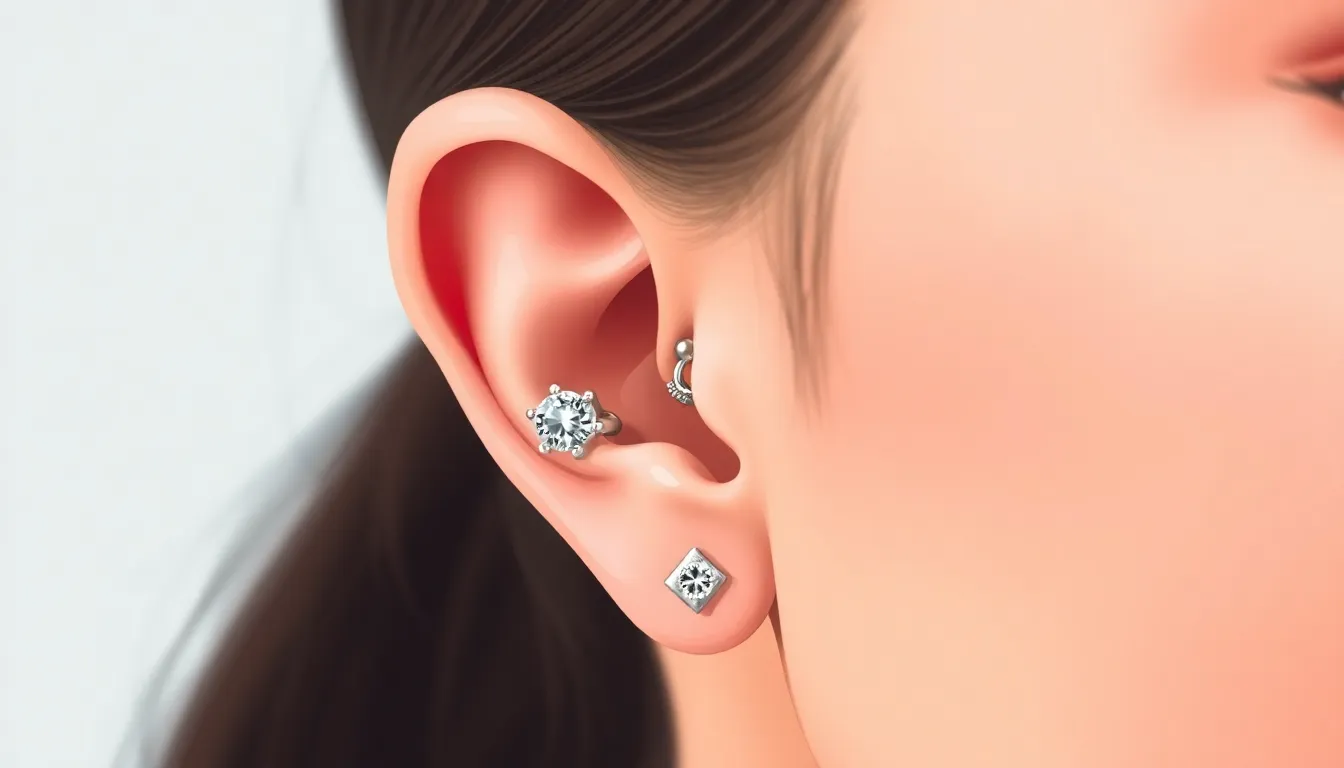Thinking about getting a daith piercing? You’re not alone! This trendy accessory has taken the piercing world by storm, promising not just style but also potential relief from migraines. But let’s be real—how much pain are you really signing up for?
Table of Contents
ToggleOverview of Daith Piercing
Daith piercings have surged in popularity, attracting attention for both their aesthetic appeal and potential health benefits. Considered a unique kind of ear piercing, this procedure involves placing jewelry through the cartilage of the inner ear, located above the ear canal. Many individuals seek out daith piercings for their stylish appearance, while others believe they may alleviate migraine symptoms.
Pain associated with daith piercings generally falls on a subjective scale. Typically, it ranges from 1 to 10, with most people rating the pain between 4 and 6. Various factors influence this pain level, including individual pain tolerance, the skill of the piercer, and aftercare practices. The cartilage area is known to be more sensitive than fleshy regions, contributing to a heightened level of discomfort during the procedure.
Healing time for daith piercings varies among individuals, averaging around three months. Swelling and tenderness commonly occur, but these symptoms usually diminish within a few weeks when proper aftercare is followed. Cleaning the piercing with saline solution and avoiding contact with unwashed hands significantly aids in recovery.
Overall, the decision to proceed with a daith piercing involves weighing the perceived benefits against potential discomfort. Individuals should consider consulting with experienced professionals to gain insights into the process, ensuring a positive and rewarding experience.
Understanding Pain Scales

Pain scales, such as the 1-10 scale, offer a way to express discomfort levels experienced during procedures like piercings. This scale ranges from no pain at 1 to unbearable pain at 10, providing a standardized method for individuals to communicate their sensations effectively.
What is the 1-10 Pain Scale?
The 1-10 pain scale serves as a common metric for measuring pain intensity. A rating of 1 indicates minimal discomfort, while 10 signifies extreme pain. People use this scale to describe their experiences with various activities, including daith piercings. Individual differences in pain tolerance significantly impact ratings, with common piercings often averaging between 4 and 6. Understanding this scale helps potential clients manage expectations regarding pain before undergoing the procedure.
How Pain Scales are Used in Piercing
Pain scales play a crucial role in the piercing process. Clients use these scales to express their pain levels, guiding piercers in adjusting techniques accordingly. For instance, a lower rating may suggest that the client feels comfortable, while higher scores indicate a need for more careful handling. Skilled piercers assess these ratings to enhance their approach, ensuring a smoother experience. By factoring in individual responses, professionals can tailor the procedure to reduce discomfort effectively.
Daith Piercing Pain Rating
Understanding the pain associated with a daith piercing helps clients prepare for the experience. Pain levels typically range from 4 to 6 on a scale of 1 to 10, influenced by personal pain tolerance and the piercer’s expertise.
Initial Pain Experience
During the initial piercing, most individuals report feeling a sharp but brief sensation. The placement of the needle through the cartilage creates a notable sting, but this discomfort fades quickly. Various factors, such as anxiety levels and individual sensitivity, can also impact the pain felt during this procedure. Immediate tenderness may occur afterward, leading to a sensation similar to a throbbing ache. Many find that with proper aftercare, any lingering pain significantly diminishes within days.
Comparing Pain Levels with Other Piercings
When comparing daith piercings to others, they tend to be comparable to cartilage piercings like helix or tragus. Cartilage piercings often register higher on the pain scale, typically between 5 and 7. Clients may find that while every person experiences pain differently, the daith piercing provides a manageable discomfort level. Additionally, some individuals report that the aesthetic appeal and potential benefits outweigh any temporary pain. Overall, being aware of these comparisons aids in setting realistic expectations before getting pierced.
Influencing Factors on Pain Perception
Pain perception during a daith piercing varies significantly based on several key factors. Understanding these elements helps potential clients manage their expectations.
Individual Pain Tolerance
Individual pain tolerance plays a crucial role in how one experiences discomfort during a daith piercing. Each person has a unique threshold for pain influenced by various factors such as previous experiences, anxiety levels, and overall health. Some may rate the pain as low as 3, while others may perceive it closer to a 7 on the 1-10 scale. Emotional state can heighten or lessen pain perception. For instance, those who remain calm often report lower discomfort levels. Additionally, individuals with high pain tolerance may minimize their experience, while those with lower tolerance can find the process more daunting.
Professional Skill of the Piercer
The skill of the piercer significantly affects pain levels during a daith piercing. Experienced piercers tend to perform the procedure with precision, reducing potential discomfort. Knowledgeable professionals employ techniques to minimize pain by ensuring quick and efficient placement of the jewelry. Reviews often highlight that skilled piercers make the experience less painful, which may result in a pain rating around 4. Recommendations from satisfied clients can help gauge a piercer’s expertise. Additionally, piercers who emphasize comfort and communication can further enhance the experience, allowing clients to feel more at ease.
Aftercare and Pain Management
Proper aftercare plays a crucial role in managing pain and ensuring a smooth healing process for a daith piercing. Clean the piercing site regularly using saline solution or a mild antiseptic recommended by a professional. Swelling and tenderness are common, but these symptoms typically decrease with diligent care.
Maintaining hygiene is essential. Avoid touching the piercing with dirty hands and refrain from changing jewelry too soon. Doing this minimizes the risk of infection. Pain often subsides within days, but some individuals may experience discomfort for a longer duration.
Consider using ice packs to alleviate swelling and numb the area. Applying the ice pack for short intervals can provide significant relief. Over-the-counter pain relievers, like ibuprofen or acetaminophen, can also help manage pain effectively. Following the recommended dosage is important to ensure safety.
Expect the healing period to last around three months. During this time, continue practicing aftercare consistently. Monitor for any signs of infection, such as increased redness, persistent swelling, or discharge. If these symptoms arise, consulting a healthcare professional is vital for addressing any complications.
Reviewing aftercare instructions thoroughly helps individuals understand the importance of following a structured routine. With the right approach, healing can proceed smoothly, making the overall daith piercing experience more enjoyable. Prioritizing aftercare not only reduces discomfort but also enhances the likelihood of achieving the desired aesthetic results.
Daith piercings offer a unique blend of style and potential health benefits. While the pain associated with the procedure typically falls between 4 and 6 on the 1-10 scale, individual experiences can vary significantly. Factors like pain tolerance and the skill of the piercer play crucial roles in shaping one’s perception of discomfort.
With proper aftercare, most individuals find that any lingering pain subsides quickly, allowing them to enjoy their new piercing. As the healing process unfolds over three months, maintaining hygiene and following recommended care practices is vital for a positive experience. Ultimately, those considering a daith piercing should weigh the aesthetic appeal against the temporary discomfort, ensuring they choose a skilled professional for the best results.













